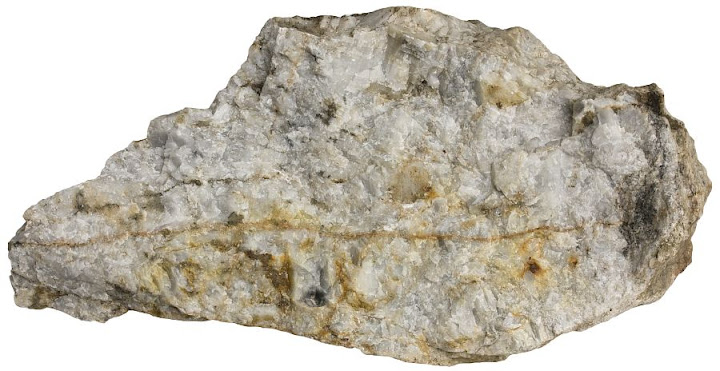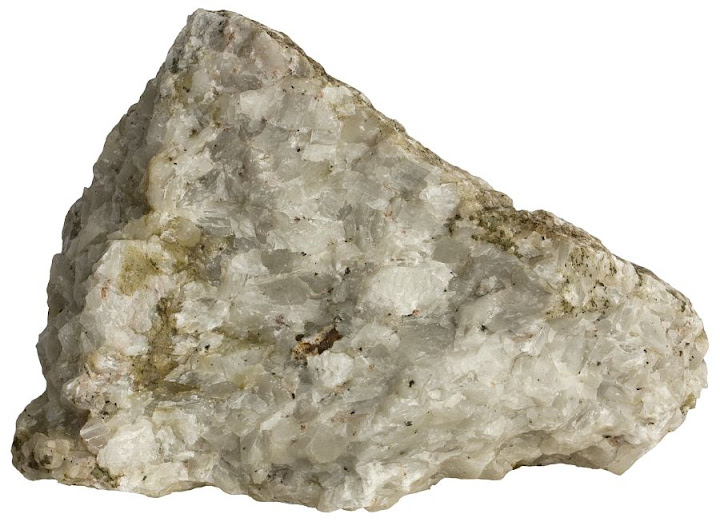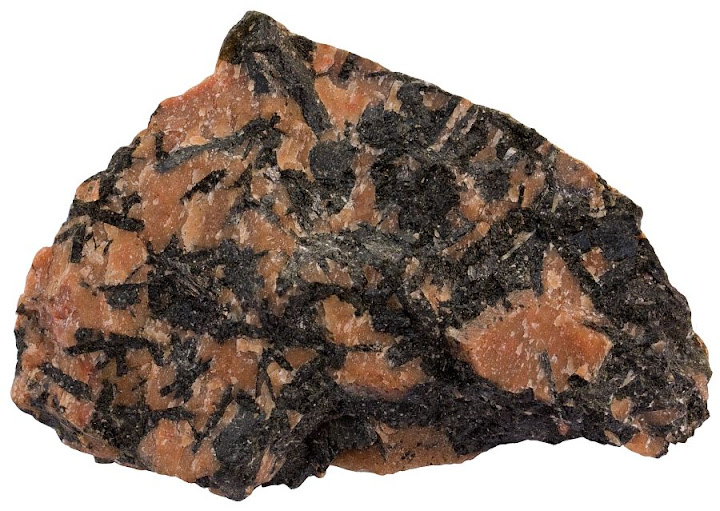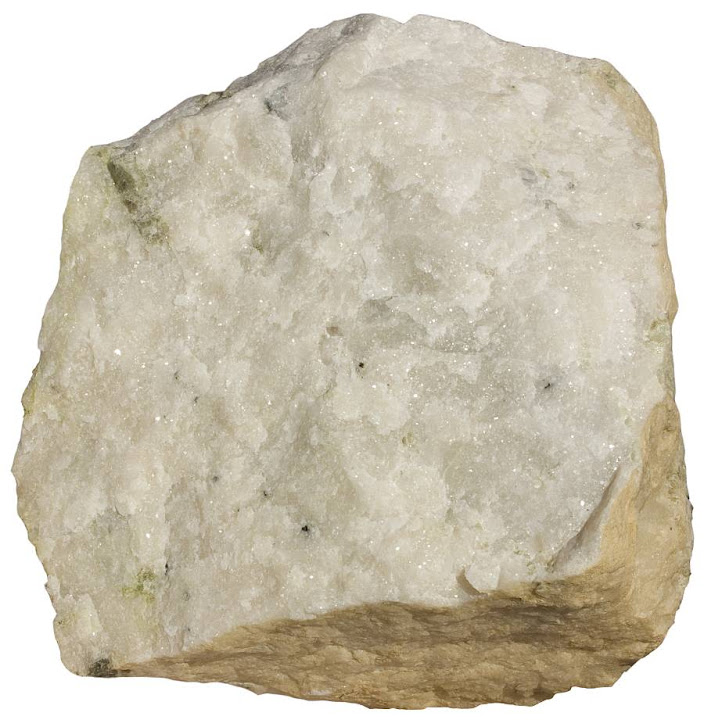Carbonatite is an igneous rock composed of at least 50% carbonate minerals1. Most carbonatite occurrences are intrusive rocks but some are volcanic. This is a deviation from a common practice in geology. Gabbro and basalt, granite and rhyolite, and many other such pairs are compositionally equivalent but named differently because the former is intrusive and the latter volcanic. Why is there an exception for carbonatites? Probably for two reasons.

Intrusive calcite-carbonatite (sövite) from the type locality. Sövite (also spelled sovite) is a carbonatite with calcite as the dominant carbonate mineral. Søve, the Fen Complex, Norway. Width of sample 16 cm.
Firstly, carbonatites are exotic rocks. Their composition is truly unusual. The vast majority of igneous rocks are silicic. Carbonate igneous rocks are grouped together because they stand out. Another reason may be the relative scarcity of these rocks. Carbonatites were once considered to be very rare oddities. This is not anymore the case. We have discovered more than 500 occurrences worldwide from different tectonic settings6. Carbonatites even occur on oceanic islands. But they continue to be somewhat enigmatic rocks because their formation mechanisms are still a matter of debate and it even took some considerable time until scientists were certain that carbonatites are really true igneous rocks. Evidence supporting this claim is overwhelmingly strong. We have seen modern flowing carbonatitic lava (Ol Doinyo Lengai volcano in Tanzania), have found Pele’s tears, chilled margins, dikes, plutons, etc.
Classification
The dominant carbonate mineral in most carbonatites is calcite. These carbonatites are named calcite-carbonatites. If plutonic, calcitic carbonatite is named sövite (sovite) and alvikite when volcanic. Dolomite-carbonatites (also known as beforsite) and ferrocarbonatites (ankerite or siderite is the Fe-bearing carbonate mineral) are less abundant types of carbonatites and natrocarbonatite is very rare – Ol Doinyo Lengai volcano is erupting natrocarbonatitic lava. This lava is composed of minerals nyerereite and gregoryite — very rare sodium-, potassium-, and calcium-bearing carbonate minerals. Igneous rocks that contain less than 50% (but more than 10%) of carbonate minerals should be named carbonatitic ijolite, nephelinite or whatever the dominant rock type happens to be. Igneous rocks with less than 10% carbonate minerals are carbonate- or calcite-bearing rocks.
Another way to classify carbonatites is to use the bulk chemical composition of the rock. Calciocarbonatite, magnesiocarbonatite and ferrocarbonatite are the three most common types of carbonatites according to this scheme. Calciocarbonatite has to be at least 80% pure CaO (in a ternary plot of Ca-Mg-Fe). If the rock contains more than 20% magnesium (MgO) and iron (with manganese) (Feo + Fe2O3 + MnO) then it is either magnesiocarbonatite or ferrocarbonatite (depending on which of them is more abundant). Silicocarbonatite is a carbonatite that is rich in silicate minerals (SiO2 > 20%). Chemical classification is used if the composition is very complex or if the rock is too fine-grained for the mineralogical composition to be accurately determined5.

Volcanic calcite-carbonatite (alvikite) from Miocene. Badberg, Kaiserstuhl, Germany.
Composition
Major minerals of carbonatitic igneous rocks are various carbonates (calcite, dolomite, ankerite, siderite, bastnäsite, nyerereite, gregoryite, burbankite, parisite).
Other minerals that frequently occur in carbonatite are phosphates apatite and monazite; halides fluorite, sylvite, and halite; oxides pyrochlore, magnetite, perovskite, baddeleyite, hematite, ilmenite; sulfides pyrite, pyrrhotite, galena, and sphalerite; and silicates olivine, micas (phlogopite, vermiculite), pyroxenes (diopside, aegirine-augite), and amphiboles.
| Elements | Calcite-carbonatite | Dolomite-carbonatite | Ferrocarbonatite | Natrocarbonatite |
|---|---|---|---|---|
| SiO2 | 2.72 | 3.63 | 4.70 | 0.16 |
| TiO2 | 0.15 | 0.33 | 0.42 | 0.02 |
| Al2O3 | 1.06 | 0.99 | 1.46 | 0.01 |
| Fe2O3 | 2.25 | 2.41 | 7.44 | 0.05 |
| FeO | 1.01 | 3.93 | 5.28 | 0.23 |
| MnO | 0.52 | 0.96 | 1.65 | 0.38 |
| MgO | 1.80 | 15.06 | 6.05 | 0.38 |
| CaO | 49.10 | 30.10 | 32.80 | 14.00 |
| Na2O | 0.29 | 0.29 | 0.39 | 32.20 |
| K2O | 0.26 | 0.28 | 0.39 | 8.38 |
| P2O5 | 2.10 | 1.90 | 1.97 | 0.85 |
| H2O+ | 0.76 | 1.20 | 1.25 | 0.56 |
| CO2 | 36.6 | 36.8 | 30.7 | 31.6 |
| BaO | 0.34 | 0.64 | 3.25 | 1.66 |
| SrO | 0.86 | 0.69 | 0.88 | 1.42 |
| F | 0.29 | 0.31 | 0.45 | 2.50 |
| Cl | 0.08 | 0.07 | 0.02 | 3.40 |
| S | 0.41 | 0.35 | 0.96 | no data |
| SO3 | 0.88 | 1.08 | 4.14 | 3.72 |
| Li | 0.1 | no data | 10 | 270 |
| V | 80 | 89 | 191 | 116 |
| Zn | 188 | 251 | 606 | 88 |
| Rb | 14 | 31 | no data | 178 |
| Y | 119 | 61 | 204 | 7 |
| Zr | 189 | 165 | 127 | 2 |
| Nb | 1204 | 569 | 1292 | 28 |
| Mo | no data | 12 | 71 | 125 |
| Pb | 56 | 89 | 217 | 22 |
| Th | 52 | 93 | 276 | 4 |
| La | 608 | 764 | 2666 | 545 |
| Ce | 1687 | 2183 | 5125 | 645 |
| Pr | 219 | 560 | 550 | 19 |
| Nd | 883 | 634 | 1618 | 102 |
| Sm | 130 | 45 | 128 | 8 |
| Gd | 105 | no data | 130 | 2 |
Average chemical composition of major (in weight percents) and minor elements Li-Gd (in parts per million) of four major carbonatite types6. Only these minor elements are shown which exceed 100 ppm in at least one carbonatite type.
Natrocarbonatite is markedly different from the other types and is usually considered to be a very special case rarely encountered in nature. Other carbonatite types are geochemically more similar to each other.

Carbonatite may strongly resemble marble, but chemical analysis will easily solve the question. Carbonatites are all rich in light rare earth elements (>500 ppm). They also have elevated concentration of strontium (>700 ppm), barium (>250 ppm) and vanadium (>20 ppm)6. Calcite-carbonatite (sövite) from Alnö Island, Sweden. Width of sample 8 cm.
Occurrence
Carbonatite occurrences are small, but they are widely distributed. Regions that stand out with many carbonatite locations are Fennoscandia, Quebec (and other provinces of Canada), Eastern Africa, Southern Africa (almost half of all carbonatite occurrences are in Africa), India, etc. Oceanic islands with carbonatite occurrences are Fuerteventura (the Canary Islands) and Santiago (Cape Verde). Carbonatites have been found from all continents, including Antarctica. They were once considered to be a result of continental rifting. Now we know that only about half of them are indeed associated with rifting-related magmatic processes. Others are related to large faults and magmatic upwellings.
Carbonatite, although volumetrically insignificant, is important rock type scientifically. There are perhaps several different mechanisms that can lead to the formation of these rocks, but one of the most seriously considered mechanisms is a very low degree (<0.01%) of partial melting of parent rocks. Carbonatite occurrences are sensitive indicators of thermal instabilities in the mantle. They may mark the locations of deep mantle plumes, astenospheric upwellings, crustal delamination, etc6. Carbonatites also provide valuable information about the composition of the mantle because these rocks almost certainly originate from below the crust.
It is interesting that almost all carbonatite bodies are within or found next to silicic rocks with unusually alkaline chemical composition. Carbonatite body together with associated alkaline rocks is known as carbonatite complex. Rocks that are commonly associated with carbonatites are nephelinite, phonolite, nepheline syenite, ijolite, melilitite, pyroxenite, syenite, lamprophyres, etc. These are mostly silicic rocks that are unusually rich in alkali metals and relatively poor in silica. They do not contain quartz because most of the available silica is consumed by feldspars and some (if not most) by feldspathoids (nepheline dominantly) because even feldspars have too high silica to alkali metals ratio for these magmas. The association of highly alkaline magmas and carbonatites that repeats itself over and over in many localities means that the mechanism behind their origin has to enable the formation of both rock types.

Carbonatites seem to be associated with alkaline igneous rocks. The association of carbonatite with such rocks is known as carbonatite complex. This rock sample is ijolite. It is composed of alkali pyroxene (aegirine-augite or aegirine) and nepheline (red). Alnö island, Sweden. Width of sample 5 cm.
Viscosity
The main physical property that separates carbonatitic magma from more common silicic magma is viscosity. Silicic magmas are highly viscous and the more silica they contain, the more viscous they get. Carbonatitic magma, however, is an ionic liquid. There is no polymerization between silica tetrahedra because they are almost absent. Carbonatitic magma may therefore travel in the crust very rapidly (tens of meters per second). The flow of carbonatitic lava is also very rapid and can easily engulf people trying to run away from it. Something like that could not happen with common silicic lava.
Field relations
In terms of field relations carbonatites are pretty usual magmatic rocks. They occur in plutons, dikes, sills, cone sheets and sometimes as volcanic rocks (both pyroclastic tuffs and lavas exist). Most of them are plutonic. About 40 are extrusive and nine of them lavas6.

Calcite-carbonatite from Alnö, Sweden. Alnö carbonatites occur in linear dikes and they are found together with highly alkaline rocks (ijolite). Width of sample 13 cm.
Ages
Carbonatite magmatism is not a new phenomenon. Oldest dated carbonatite rocks are from the Archaean. Tupertalik (3.0 Ga) in Greenland is the oldest. The youngest are modern lavas from the Ol Doinyo Lengai. Carbonatite magmatism seems to become more intense towards recent times. It may be a real trend which reflects the much lower geothermal gradient now which may be needed for a very low degree of partial melting. On the other hand, large part of carbonatite occurrences (especially extrusive carbonatites) may have been lost because they are not among the most easily preserved rock types.
Uses
Carbonatite is the principal source of niobium which comes from the mineral pyrochlore (mined in Brazil and Canada — Araxá, Tapira, and St. Honoré mines). Carbonatites also contain lots or rare earth elements. They can be extracted from primary magmatic minerals or from minerals deposited from hydrothermal fluids. The most important REE-bearing minerals are bastnäsite, monazite, britholite, burbankite, parisite, and synchesite. Carbonatites are also important source of phosphates because apatite is a very common primary magmatic mineral in carbonatites. Notable apatite mines are located in Kola peninsula (Russia) and Siilinjärvi (Finland). Phosphates may be very abundant in carbonatites which explains why more money is made from this commodity than from any other mineral found in carbonatite. Carbonatite may be also mined as a source of fluorine (mineral fluorite deposited from hydrothermal solutions). Some carbonatites contain appreciable amount of thorium and uranium (minerals monazite and thorite). Titanium may be extracted from anatase and perovskite and carbonatite from Uzbekistan is known to contain very small diamonds. This discovery may be more important scientifically than economically because diamonds need very high pressure to form which supports the theory that carbonatites originate from the mantle and were subjected to considerable compressive forces. Vermiculite is also mined from carbonatitic rocks in Brazil (Ipanema).

Rödbergite is a dolomite-calcite-carbonatite from the Fen complex that is reddish due to finely dispersed hematite, goethite and martite (hematite pseudomorphs after magnetite). The rock has been mined in the past (1652-1927) as an iron ore. In addition to iron the rock has elevated concentration of thorium and rare earth elements2. Rödbergite seems to be a hydrothermally altered magnetite- and pyrite-bearing ankerite-ferrocarbonatite (rauhaugite) found nearby. It is estimated that about one million tons of ore were mined and current reserves are of the same order of magnitude3. This sample although clearly rusty in appearance is relatively poor in iron-bearing minerals. Massive and easily accessible iron ore has been largely removed during the centuries of mining which reached over hundred meters in depth. Rødberg, the Fen Complex, Norway. Width of sample 13 cm.

An outcrop of rödbergite. The Fen Complex, Norway.

Sövite from Siilinjärvi, Finland. Green mineral is fluor-apatite. Width of sample 18 cm.

Siilinjärvi carbonatite is mined as a source of phosphate (green fluor-apatite). Dark spot is Mg-biotite phlogopite. Siilinjärvi carbonatite is among the oldest (from the Archaean) known carbonatites in the world. Width of sample 19 cm. By the way, this sample resembles hedgehog for some. Find out that the association goes beyond mere visual resemblence: Hedgehog rock.

Siilinjärvi carbonatite is largely a mixture of carbonatite-glimmerite (biotitite). The latter is an ultramafic rock composed of biotite (variety phlogopite in this case with alkali amphiboles richterite and riebeckite4). Width of sample 11 cm.

Glimmerite with green fluor-apatite crystals and calcite. This sample is not carbonatite because carbonate minerals clearly constitute less than half of the rock. It should be named carbonatitic biotitite5 (or carbonatitic glimmerite). Siilinjärvi, Finland. Width of sample 9 cm.
Origin
The question of how is such an unusual magma generated has been an intriguing problem for a long time and is still waiting for a satisfying explanation. There are three major hypotheses. Carbonatitic magma may be a direct partial melt of mantle rocks. In this case the source rock has to melt very slightly (<0.01%). Carbonatite may form as an immiscible blob of liquid. In this case alkaline and carbonatitic magma are like oil and water that do not form homogenous solutions. And finally carbonatitic magma may be generated as a result of extreme crystal fractionation. It seems likely that all three may be part of the explanation and even within one complex the formation mechanism may involve several of the aforementioned mechanisms. For example: it began with partial melting deep in the mantle. The melt migrated upward and separated into alkaline and carbonatitic melts and possibly had some already formed crystals removed from the melt through crystal fractionation. The exact mechanism is almost certainly unique to every specific carbonatite complex and it seems likely that carbonatites form in more than one way.
The source of the carbonatitic magma may be primary or recycled crustal rocks (subducted carbonate rocks). The current consensus based mostly on isotopic data seems to support the version that carbonatitic magma is primary (carbon dioxide-bearing mineral phases were present in the mantle since the formation of the Earth).
Fenitization
Hydrothermal fluids from carbonatitic and alkaline magma infiltrate the country rocks surrounding the complex and alter their composition. This metamorphic process is known as fenitization and the rock so formed as fenite. Minerals formed through this process involve sodic pyroxenes and amphiboles, feldspar, feldspathoids and calcite. Fenitization within the mantle may play an important role in the generation of several other exotic igneous rocks like kimberlites and lamproites.

Country rocks surrounding the carbonatite complex are commonly metasomatically altered by the hot fluids from the cooling complex. Such rocks are known as fenite. This sample is composed of carbonatitic vein (dark-colored) and metasomatically altered migmatitic gneiss (now fenite) which is composed of alkali pyroxenes, alkali amphiboles, calcite, nepheline, alkali feldspar, titanite, fluorite, etc. Alnö, Sweden. Width of sample 10 cm.

Impure carbonatite with abundant alkaline silicate minerals (silicocarbonatite or fenitic carbonatite). Alnö, Sweden. Width of sample 11 cm.
References
1. Bell, Keith, ed. (1989). Carbonatites — Genesis and Evolution.
2. Bergstøl, Sveinung & Svinndal, Sverre. (1960). The carbonatite and per-alkaline rocks of the Fen area.
3. Andersen, Tom. (1983). lron ores in the Fen central complex, Telemark (S. Norway): Petrography, chemical evolution and conditions of equilibrium.
4. Puustinen, Kauko. (1971). Geology of the Siilinjärvi carbonatite complex, Eastern Finland.
5. Le Maitre, R. W. (2005). Igneous Rocks: A Classification and Glossary of Terms: Recommendations of the International Union of Geological Sciences Subcommission on the Systematics of Igneous Rocks, 2nd Edition. Cambridge University Press.
6. Bell, K. (2004). Carbonatite. In: Encyclopedia of Geology, Five Volume Set. Academic Press. 217-233
Leave a Reply